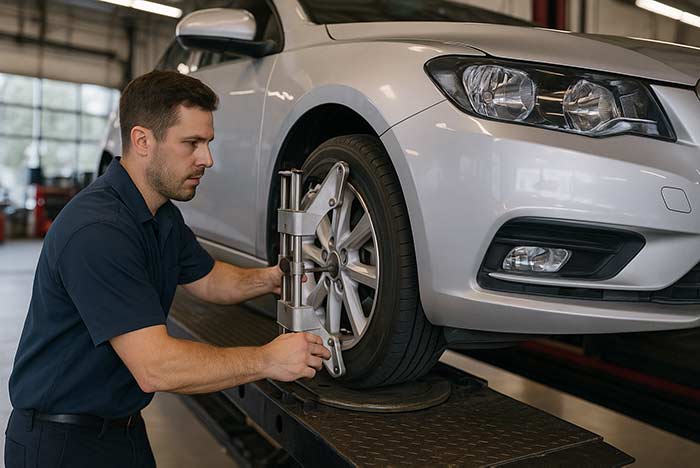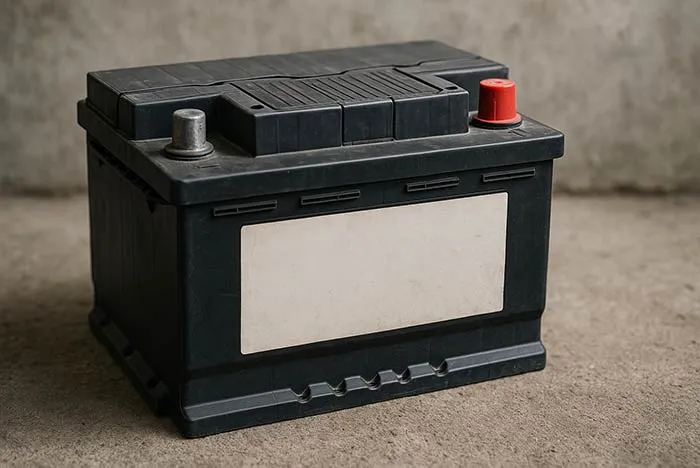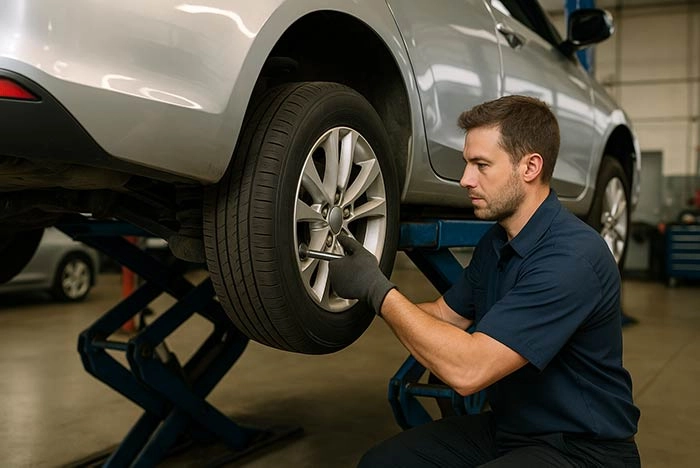
Wheel alignment is one of those car services many people ignore—until the tires wear out too fast or the steering feels off. But getting your alignment checked regularly can save you money, extend tire life, and keep your car handling safely.
So, what is wheel alignment exactly? This is the process of adjusting the vehicle’s suspension angles, so all four wheels are pointing in the right direction. In case the alignment is off, even slightly, that can cause poop handling, uneven tire wear and even bad fuel efficiency.
We will try to explain what car alignment is, how to tell if the alignment is off, what causes it and whether you need one when getting new tires. You’ll also learn how long it takes, how long it typically lasts, and what to expect if you try doing it yourself.
What Is Wheel Alignment (and What Is a Car Alignment?)
Wheel alignment is adjusting the angles of your car’s suspension so the wheels sit straight and flat on the road. It does not require to change the wheels or the tires, it only about the whole they are positioned relative to the frame and each other.
A proper car alignment makes sure that all the tires are angled correctly and have the perfect contact on the road surface. When the four wheels are aligned properly the car drives straight, handles perfectly and the tires wear evenly.
There are three key alignment angles:
- Toe – Think of looking down at your feet. If they point in or out instead of straight ahead, that’s toe-in or toe-out. Same for wheels. Poor toe settings cause the steering to feel twitchy or make the car drift sideways.
- Camber – This is the inward or outward tilt of the wheel when viewed from the front. Too much inward (negative camber) or outward (positive camber) can lead to uneven tire wear on one side.
- Caster – This is the angle of the steering axis when viewed from the side. Positive caster helps with high-speed stability and steering return. Too much or too little can affect how the car feels when turning.
Modern shops use laser-guided or computerized alignment systems to measure and adjust these angles to exact specifications from the manufacturer.
Tip:
In short, wheel alignment keeps your tires pointing in the right direction, makes sure your car drives straight, and helps everything wear evenly—from rubber to suspension parts.
How to Tell If Alignment Is Off
Most drivers notice something’s wrong before they ever think “alignment.” That’s because misaligned wheels affect how your car feels and how your tires wear. Here are the most common signs:
1. Car Pulls to One Side
Let go of the wheel (briefly, on a flat and safe road). The car should cruise straight and not drift left or right side, alignment is likely off. That could be also a tire pressure issue, if the tires are fine it is likely to be alignment.
2. Steering Wheel Isn’t Centered
When driving straight, your steering wheel should sit level and centered. If it’s tilted to one side, or you have to hold it off-center to drive straight, that’s a classic sign of misalignment.
3. Uneven Tire Wear
Check your tires. If the tread is wearing more on one edge than the other—or differently between tires—your alignment is out of spec. Toe and camber issues usually cause this.
4. Vibration or Loose Steering
Misaligned wheels can cause steering wheel vibration, especially at highway speeds. You might also feel looseness or wandering, like the car isn’t as stable as usual.
5. Squealing Tires in Turns
If your tires squeal when cornering at moderate speed, it could be alignment forcing them to slide slightly instead of rolling cleanly.
6. You Hit a Pothole or Curb
Even if everything feels fine, a big hit to a pothole or curb can knock your wheels out of alignment. It’s a good idea to get it checked after a jolt like that.
Tip
Even small misalignment can get expensive over time. Worn tires, poor fuel economy, and extra stress on steering components add up. Catching these signs early saves money and keeps your car safe.
What Causes Bad Wheel Alignment?
Your car doesn’t go out of alignment on its own. Something has to shift, bend, or wear out. Here are the most common causes:
1. Potholes and Road Damage
Hitting a deep pothole at speed can jolt your suspension hard enough to knock your wheels out of alignment. Rough roads are a major reason alignment issues sneak up on drivers.
2. Curb or Parking Block Hits
Lightly tapping a curb during parking might not feel serious—but it can bend suspension arms or misalign steering components. Even low-speed hits can throw off your alignment angles.
3. Accidents or Fender Benders
Any kind of collision—even a minor one—can shift parts of the suspension or steering geometry. It’s one of the first things to check after a crash.
4. Worn Suspension Parts
Over time, suspension bushings, ball joints, tie rods, and control arms wear out. When they loosen, alignment angles can drift. If your car is older, even normal driving can cause this.
5. Lift Kits or Suspension Modifications
If you’ve raised or lowered your vehicle without adjusting the alignment, it’s likely off. Suspension geometry changes with ride height, so you need a fresh alignment after modifying springs or shocks.
6. Uneven Weight Load
Consistently carrying heavy loads on one side—or towing often—can stress the suspension unevenly and cause alignment to shift gradually.
Tip:
The takeaway? Most alignment problems are mechanical—caused by impact, wear, or changes in the suspension. Regular checks, especially after hitting something or replacing parts, can prevent long-term damage and save you from early tire replacement.
Do I Need a Wheel Alignment With New Tires?
It is not mandatory to have alignment always when having a new tire, but it will be a good practice to do so.
1. Protects Your Tire Investment
New tires aren’t cheap. If your alignment is off, they can wear unevenly in just a few thousand miles. That means less grip, worse performance, and replacing tires way sooner than you should.
2. Ensures a Smooth Ride
The best tires will not feel right if they are fighting against poor alignment. Getting a fresh alignment will improve the ride, to track straight, and handle perfectly
3. Corrects Suspension Shifts
Installing new tires usually involves removing the wheels and working with suspension components. That’s a good time to check if anything is slightly off—especially if your old tires had uneven wear.
4. Tire Shops Often Include It
Many shops offer discounted or bundled alignments when you buy tires. Some may even require it to honor the mileage warranty on your new tires.
When You Might Skip It:
- If your old tires wore perfectly evenly
- If your steering feels solid and centered
- If you just had an alignment done recently (within a few thousand miles)
Still, it’s safer to check. An alignment check costs less than a new tire—and keeps your new set in top shape from day one.
How to Do Wheel Alignment (DIY vs Shop)?
Wheel alignment isn’t like an oil change. It’s a precise job that needs special tools, and most drivers are better off letting a shop handle it. But let’s break down both options.
Shop Alignment – The Recommended Way
Modern alignment shops use laser or computerized systems that measure your wheel angles down to a fraction of a degree. The process includes:
- Mounting sensors on each wheel
- Measuring toe, camber, and caster angles
- Comparing those angles to factory specs
- Making fine-tuned adjustments to suspension parts
Why it’s better:
- Fast and accurate (usually done in 30–60 minutes)
- Technicians spot worn components before adjusting
- Your steering and suspension stay in spec
Most shops can align both front and rear wheels, depending on the vehicle. If your car allows 4-wheel alignment, it’s best to get it done that way.
DIY Alignment – Possible, But Risky
Doing your own alignment at home is tough. It’s possible—but only with the right tools, patience, and know-how.
What You’d Need:
📏 A flat, level surface
🪜 Jack and stands
📐 Tape measure or string alignment setup
📊 Camber gauge (optional)
🔧 Basic wrenches or ratchets
📘 Alignment specs from your car’s service manual
What You Can Adjust at Home:
- Toe – With string or tape, you can measure and set front toe angle
- Camber and Caster – Much harder to set without pro tools or aftermarket kits
Why It’s Not Ideal:
- Easy to make things worse
- No way to set caster accurately without shop equipment
- One mistake can ruin your tire wear or make your car handle poorly
DIY alignment might work for race cars with adjustable suspensions or old trucks with simple front ends. But for most modern vehicles, it’s best left to a professional.
Tip
In short: You can try it yourself, but you probably shouldn’t. A $100 shop alignment is cheaper than burning through $800 in tires.
How Long Does Wheel Alignment Take?
A standard wheel alignment usually takes 30 to 60 minutes at a shop. But that can vary based on your car’s condition and the type of alignment.
What Affects the Time?
✅ 2-Wheel vs. 4-Wheel Alignment
- 2-wheel alignment (front only): ~30 minutes
- 4-wheel alignment (all wheels adjusted): 45–60 minutes
Some vehicles require all four wheels to be adjusted, especially if they have independent rear suspension.
🔧 Vehicle Type and Design
Some cars are easy to align. Others—especially trucks or performance vehicles—may need extra time due to tight components or complex setups.
🧰 Condition of Suspension and Bolts
Rust, seized bolts, or worn parts slow things down. If a shop has to free up frozen components or replace bushings before making adjustments, the job could take over an hour.
🔁 Post-Collision or New Suspension Work
Cars that have been in an accident or just had suspension parts replaced (like control arms, tie rods, or springs) may need extra steps to dial everything in.
Can I Wait While It’s Done?
Yes. Most alignments are same-day jobs, and shops often have you in and out within an hour if there are no issues. Just make sure to book ahead if you're going during a busy season (like winter-to-spring tire swaps).
Bottom line: Expect 30–60 minutes. But if your car is older, modified, or recently repaired, leave extra time in case adjustments take longer.
How Long Is a Wheel Alignment Supposed to Last?
A proper wheel alignment can last one to two years—sometimes longer. But how long it stays in spec depends on how and where you drive.
🚗 Average Lifespan of an Alignment
- 1 year is a safe bet for most drivers
- 2 years if you drive gently and roads are smooth
- Some drivers go longer if no signs of misalignment appear
There’s no fixed mileage. Some alignments stay good for 10,000 miles (16,000 km). Others can shift after just 3,000 miles (5,000 km)—especially if you hit a curb or deep pothole.
What Shortens Alignment Life?
❌ Potholes and Rough Roads
One hard hit can knock everything out of place, no matter how recently it was aligned.
❌ Aggressive Driving
Hard cornering, slamming into parking blocks, or off-roading stresses suspension parts and wears them faster.
❌ Worn Suspension Components
Ball joints, control arms, and bushings wear slowly. As they loosen, your alignment can gradually drift out of spec.
❌ Modifications or Suspension Work
Any time you change springs, shocks, lift kits, or even tires, the alignment can shift. Always get it rechecked after suspension changes.
How to Make Your Alignment Last Longer
- Drive smoothly and avoid curbs and potholes
- Check tire pressure regularly—low pressure can stress alignment angles
- Have your suspension inspected once a year
- Get alignment checked if you notice uneven tire wear or a pull in the steering
Tip:
Even if your car drives fine, it’s smart to check alignment every 12–24 months or with every new set of tires. It’s a cheap way to protect your tires and avoid steering or safety issues.
FAQ – Common Wheel Alignment Questions
1. How much does a wheel alignment cost?
The cost varies based on your vehicle and location. Generally, expect to pay between $100 and $150 for a standard alignment. Some shops offer bundled deals when purchasing new tires. High-end or European vehicles may incur higher costs due to specialized equipment or procedures.
2. Is alignment part of regular maintenance?
Yes, it is. Even if your car feels fine, alignment can drift over time due to normal driving conditions. It's advisable to have it checked annually or every 10,000 to 12,000 miles. Regular checks help prevent uneven tire wear and maintain optimal handling.
3. What’s the difference between alignment and balancing?
Alignment adjusts the angles of your wheels to ensure they are set to the manufacturer's specifications, affecting how your car handles and how evenly your tires wear. Balancing, on the other hand, ensures that the weight of the wheel-tire assembly is evenly distributed, preventing vibrations at certain speeds. Both are crucial for a smooth and safe ride.
4. Should I get an alignment after replacing suspension parts?
Absolutely. Replacing components like control arms, tie rods, or struts can alter your vehicle's alignment settings. To ensure proper handling and tire wear, it's essential to have an alignment performed after such replacements.
5. Can misalignment damage other parts?
Yes. Driving with poor alignment can lead to uneven tire wear, reducing tire lifespan. It can also strain suspension components, leading to premature wear or failure. Additionally, misalignment can affect steering responsiveness and overall vehicle safety.


